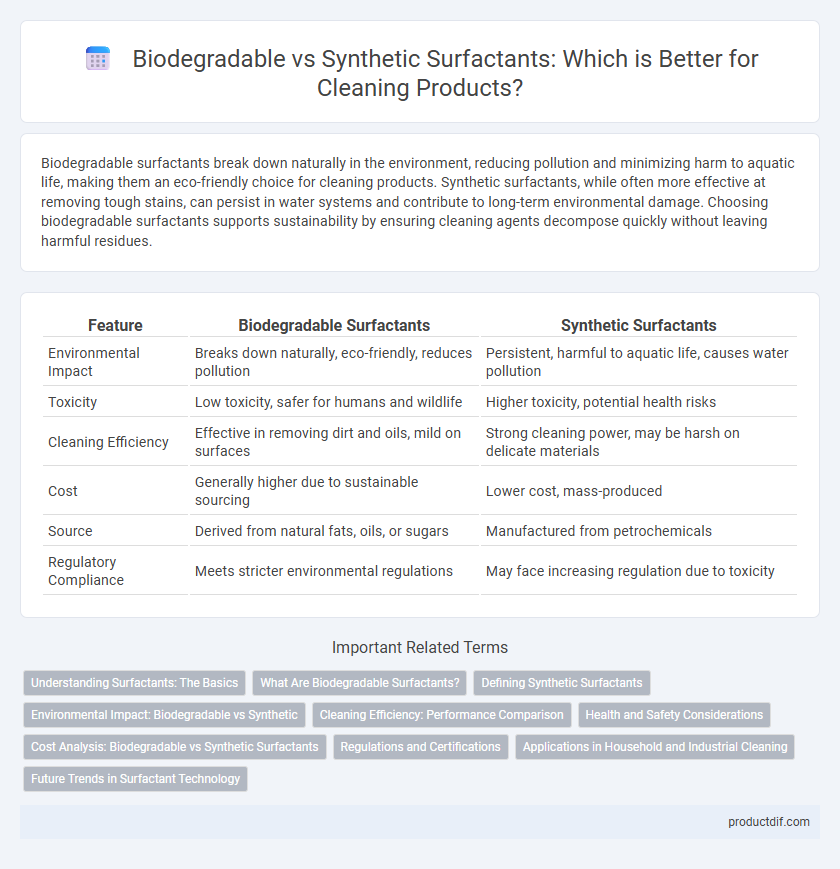Biodegradable surfactants break down naturally in the environment, reducing pollution and minimizing harm to aquatic life, making them an eco-friendly choice for cleaning products. Synthetic surfactants, while often more effective at removing tough stains, can persist in water systems and contribute to long-term environmental damage. Choosing biodegradable surfactants supports sustainability by ensuring cleaning agents decompose quickly without leaving harmful residues.
Table of Comparison
| Feature | Biodegradable Surfactants | Synthetic Surfactants |
|---|---|---|
| Environmental Impact | Breaks down naturally, eco-friendly, reduces pollution | Persistent, harmful to aquatic life, causes water pollution |
| Toxicity | Low toxicity, safer for humans and wildlife | Higher toxicity, potential health risks |
| Cleaning Efficiency | Effective in removing dirt and oils, mild on surfaces | Strong cleaning power, may be harsh on delicate materials |
| Cost | Generally higher due to sustainable sourcing | Lower cost, mass-produced |
| Source | Derived from natural fats, oils, or sugars | Manufactured from petrochemicals |
| Regulatory Compliance | Meets stricter environmental regulations | May face increasing regulation due to toxicity |
Understanding Surfactants: The Basics
Biodegradable surfactants are derived from natural sources such as plant oils and break down efficiently in the environment, reducing pollution and toxicity. Synthetic surfactants, typically produced from petrochemicals, offer strong cleaning power but tend to persist longer in ecosystems, potentially causing harm to aquatic life. Understanding surfactants involves recognizing their role in lowering surface tension to remove dirt and grease, with biodegradability being a key factor in sustainable cleaning product choices.
What Are Biodegradable Surfactants?
Biodegradable surfactants are cleaning agents derived from natural, renewable sources such as plant oils and sugars that break down quickly in the environment, minimizing pollution and toxicity. Unlike synthetic surfactants made from petrochemical compounds, biodegradable surfactants maintain effective cleaning properties while supporting eco-friendly waste management and reducing harmful impacts on aquatic life. These surfactants are crucial in sustainable cleaning products, promoting environmental safety without compromising performance.
Defining Synthetic Surfactants
Synthetic surfactants are man-made compounds derived from petrochemicals, designed to reduce surface tension in water for effective cleaning and emulsification. They are extensively used in detergents, shampoos, and household cleaners due to their strong foaming and grease-cutting properties. Unlike biodegradable surfactants, synthetic surfactants often persist in the environment, raising concerns about their ecological impact and biodegradability.
Environmental Impact: Biodegradable vs Synthetic
Biodegradable surfactants break down naturally in the environment, minimizing pollution and reducing harm to aquatic ecosystems. Synthetic surfactants often persist longer, contributing to water contamination and negatively affecting biodiversity. Choosing biodegradable options supports sustainable cleaning practices by lowering ecological footprints and promoting safer water quality.
Cleaning Efficiency: Performance Comparison
Biodegradable surfactants demonstrate competitive cleaning efficiency compared to synthetic surfactants, effectively removing grease, oils, and dirt while being environmentally friendly. Studies show biodegradable surfactants have comparable surface tension reduction and emulsification capacity, ensuring thorough soil dispersion and rinsing. Synthetic surfactants may offer faster action in some formulations but often contain petrochemical residues, whereas biodegradable options balance performance with sustainable degradation.
Health and Safety Considerations
Biodegradable surfactants typically pose fewer health risks due to their natural origin and reduced toxicity, minimizing skin irritation and allergic reactions. Synthetic surfactants often contain harsh chemicals that can cause respiratory issues and environmental hazards through bioaccumulation. Choosing biodegradable surfactants enhances safety for both users and ecosystems by promoting quicker decomposition and reduced chemical residues.
Cost Analysis: Biodegradable vs Synthetic Surfactants
Biodegradable surfactants generally have higher upfront costs compared to synthetic surfactants due to their natural raw materials and eco-friendly production processes. However, the lower environmental remediation expenses and regulatory compliance fees associated with biodegradable surfactants can result in overall cost savings in the long term. Synthetic surfactants often offer cheaper initial pricing but may incur hidden costs related to environmental impact and disposal regulations.
Regulations and Certifications
Biodegradable surfactants are increasingly favored due to stringent environmental regulations such as REACH in the EU and the Toxic Substances Control Act (TSCA) in the US, which promote eco-friendly chemical formulations. Certifications like Ecocert, USDA BioPreferred, and Green Seal specifically endorse biodegradable surfactants, ensuring compliance with sustainability standards. In contrast, synthetic surfactants often face tighter restrictions and may lack certification approvals, limiting their use in eco-conscious markets.
Applications in Household and Industrial Cleaning
Biodegradable surfactants, derived from natural sources like plant oils, are increasingly preferred in household and industrial cleaning due to their reduced environmental impact and effective grease-cutting abilities. Synthetic surfactants, commonly formulated from petrochemicals, provide strong cleaning power and stability in harsh chemical environments, making them suitable for heavy-duty industrial applications. The choice between biodegradable and synthetic surfactants depends on balancing eco-friendliness with cleaning performance requirements in various applications.
Future Trends in Surfactant Technology
Future trends in surfactant technology emphasize the shift toward biodegradable surfactants derived from renewable resources due to their reduced environmental impact and enhanced biodegradability. Advances in green chemistry are driving the development of bio-based surfactants that maintain cleaning efficacy while minimizing aquatic toxicity compared to synthetic surfactants. Innovations in enzymatic synthesis and microbial fermentation are expected to optimize production efficiency and lower costs, making biodegradable surfactants increasingly viable in commercial cleaning products.
Biodegradable surfactants vs Synthetic surfactants Infographic

 productdif.com
productdif.com